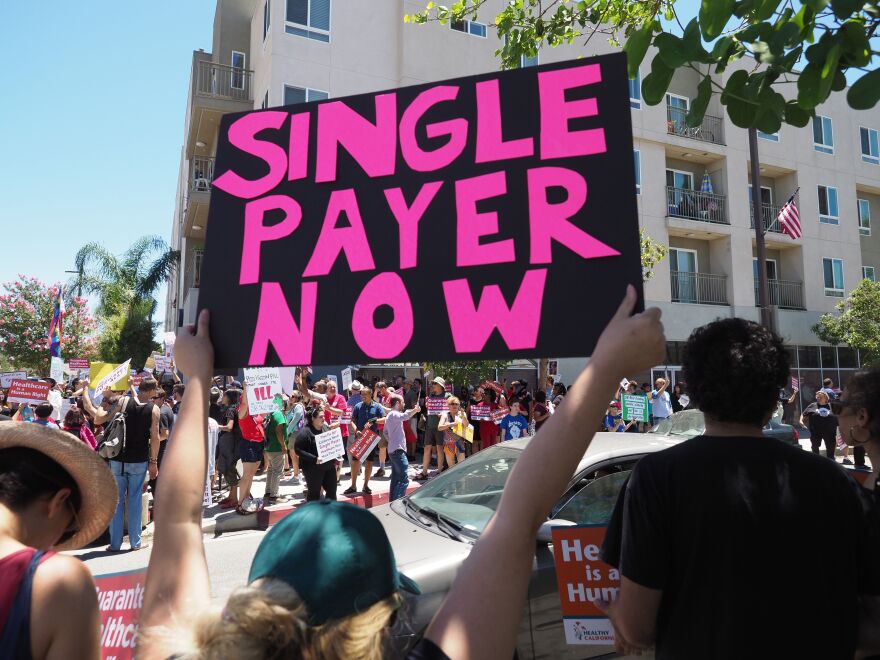Truth matters. Community matters. Your support makes both possible. LAist is one of the few places where news remains independent and free from political and corporate influence. Stand up for truth and for LAist. Make your year-end tax-deductible gift now.
This archival content was originally written for and published on KPCC.org. Keep in mind that links and images may no longer work — and references may be outdated.
3 paths to universal health care in California

The push to move California to a universal health care system enters a new phase this week, when a special committee will hear for the first time specific proposals on how the state might pursue a path to universal care.
The State Assembly's Select Committee on Health Care Delivery Systems and Universal Coverage has its two final scheduled hearings on Monday and Wednesday. On Monday, lawmakers will consider state and federal legal hurdles to universal coverage. The Wednesday hearing will be dedicated to hearing policy proposals, with testimony coming from Health Access California, Physicians Alliance and the California Nurses Association, among others.
Committee co-chair Assemblyman Jim Wood (D-Healdsburg) said the panel plans to produce a report with recommendations by the spring.
Assembly Speaker Anthony Rendon (D-Lakewood) shelved a single payer bill in June, arguing that it didn't lay out how to make such a radical transition or how to pay for it. Amid an angry backlash from progressive backers of universal care, Rendon announced the select committee set up to explore the issue.
There are a variety of possible paths California could take. But first, let’s define some terms.
"Universal health care" refers to everyone having access to quality health care without financial risk, according to the World Health Organization's definition. Despite improvements under Obamacare, nearly 3 million people in California still don’t have insurance. From the WHO's perspective, even if the state gets everyone insured, we won't have universal health care so long as there are people who can’t afford their out-of-pocket costs.
To get to universal care, activists have latched on to the concept of single-payer. That's when one entity - the state - foots the entire bill for everyone's medical treatment. It would cut out the private insurance industry, and would require a possibly significant increase in taxes. Proponents say that would be more than offset by the elimination of insurance premiums, deductibles, co-pays and other out-of-pocket costs. The bill Rendon shelved, SB 562, would have created a "Healthy California Fund" to be that single payer.
Single-payer is one approach to universal health care, but not the only one. There are many different approaches to universal care around the world. If you want to become an expert on the health care systems of 19 industrial countries, The Commonwealth Fund has this deep dive.
Among the many systems in place, most are a variation on one of the three models below.
The Canadian Model
- Upwards of 70 percent of health care is covered by the federal and provincial governments.
- Most health care providers are private.
- Each provincial government pays for care on a fee-for-service basis, covering most basic services.
- Many people have additional private insurance to cover things not covered by the government. This typically includes prescription drugs, dental care and optometry. Employers pay 90 percent of those costs.
- Average annual out-of-pocket costs per person are less than two-thirds of what we pay in the U.S.
The United Kingdom Model
- Socialized medicine.
- Doctors work for the government.
- Hospitals belong to the government.
- Care is mostly free at the point of service.
- Consumers pay higher taxes to cover the cost of the program.
- England spends just over $3,000 per person a year on health care (one-third of what the U.S. spends).
- This model is somewhat similar to the U.S. Department of Veterans Affairs' health care system.
- About 11 percent of the population gets private insurance, which provides more options and shorter wait times.
The German Model
- Everyone in Germany is required to get health insurance.
- Most people buy insurance from highly regulated nonprofit "sickness funds" that are funded by income taxes.
- Cost is based on income. Your employer pays half.
- If you can't afford insurance, the government covers most or all of the cost.
- About 10 percent of Germans sign up for supplemental private insurance, which can provide more benefits.
- Plans are heavily regulated, with out-of-pocket costs limited to between 1 to 2 percent of income.
Per capita health spending is about half of what it is in the U.S.
This story was updated from its original version.







